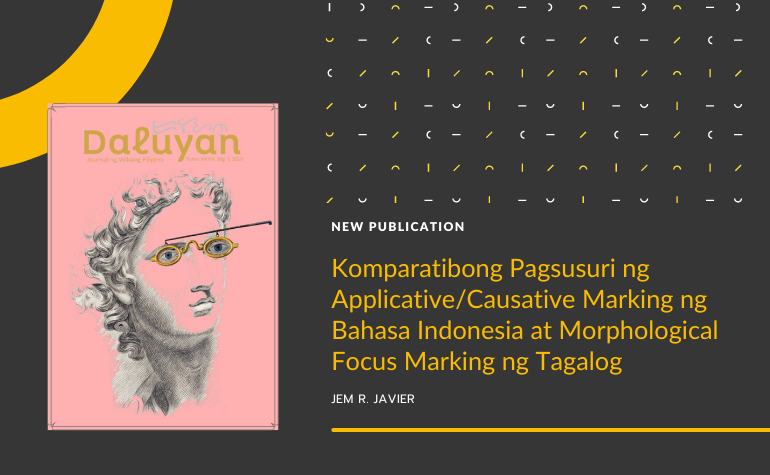
Congratulations to Asst. Prof. Jem R. Javier on the publication of his paper titled “Komparatibong Pagsusuri ng Applicative/Causative Marking ng Bahasa Indonesia at Morphological Focus Marking ng Tagalog (Comparative Analysis of Applicative/Causative Marking in Indonesian and Morphological Focus Marking in Tagalog)”! The paper was published in Daluyan: Journal ng Wikang Filipino (Vol. 27, No. 1) which is now available online. Below is the abstract of Jem’s paper.
Komparatibong Pagsusuri ng Applicative/Causative Marking ng Bahasa Indonesia at Morphological Focus Marking ng Tagalog
Tatangkain ng papel na ito na suriin ang estruktura ng mga verbal sentence ng Bahasa Indonesia na naglalaman ng mga hulaping applicative/causative na -kan at -i mula sa pananaw ng morphological focus system na siyang ginagamit naman sa paglalarawan sa Tagalog, isang Philippine-type na wika. Samantalang ang masalimuot na verbal morphology ng mga wikang Philippine-type ang tumutukoy sa complement na nagsisilbing grammatical subject, ang mga hulaping -kan at -i sa isang Indonesian-type na wika gaya ng Bahasa Indonesia ang naghuhudyat (trigger) sa pagpili ng direct object ng verbal predicate. Mula rito at sa datos na nakalap mula sa iba’t ibang teksbuk at panayam sa mga informant, tatangkain ng pag-aaral na ito na tingnan ang mga posibleng magkakatumbas na kayarian sa pagitan ng grammatical-subject marking ng Tagalog at direct object-marking ng Bahasa Indonesia, at tatalakayin ang implikasyon nito sa pagtuturo ng Bahasa Indonesia sa mga tagapagsalita ng Tagalog, at maging sa pagsasalin mula sa Bahasa Indonesia patungong Tagalog at vice versa.
_________________________________________________________________________________
This paper attempts to analyze the structure of Indonesian verbal sentence containing the applicative/causative suffixes -kan and -i from the perspective of the morphological focus system used in describing Tagalog, a Philippine-type language. Whereas the complex verbal morphology in Philippine-type languages indicates which complement serves as the grammatical subject, the suffixes -kan and -i in an Indonesian-type language such as Bahasa Indonesia trigger the choice of the direct object of the verbal predicate. With these in mind and gathering data from the different pedagogical textbooks and informant work, this study aims to look at the possible equivalent structures between the grammatical-subject marking of Tagalog and direct object-marking in Indonesian, and to discuss their implications for teaching Indonesian to Tagalog-speaking learners as well as doing translation work from Indonesian to Tagalog and vice versa.
To download and read the paper, visit the website of Daluyan.
Published by UP Department of Linguistics



